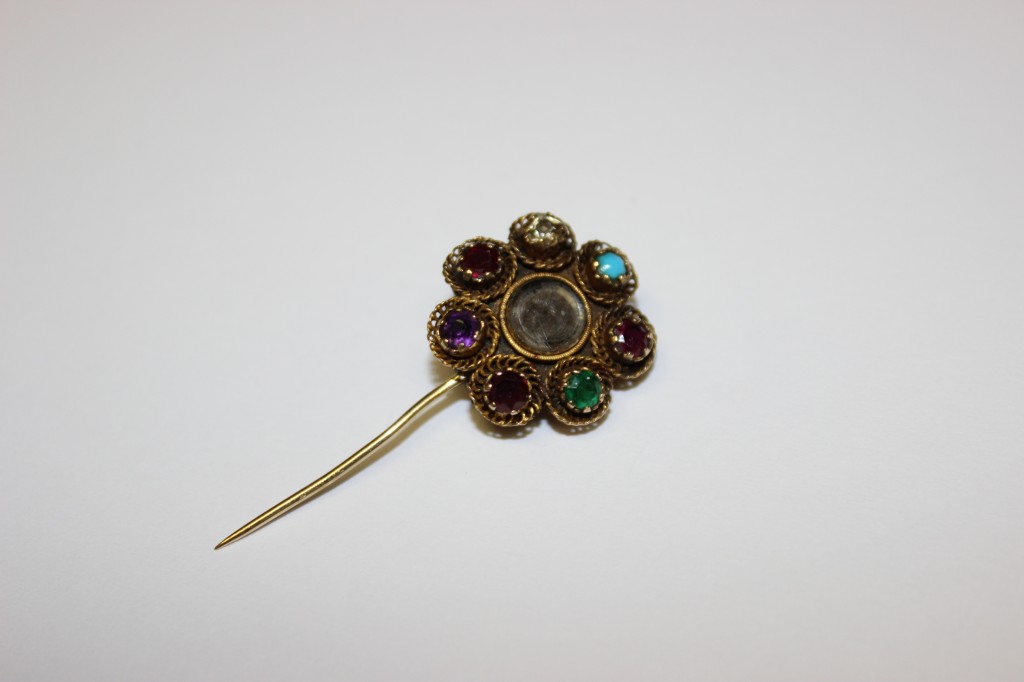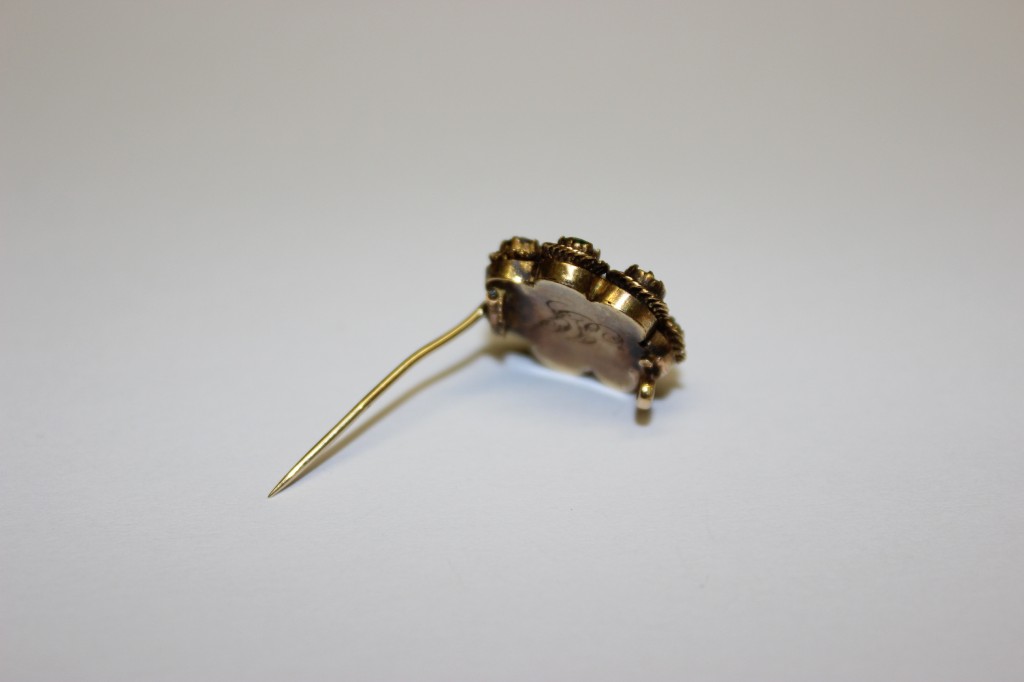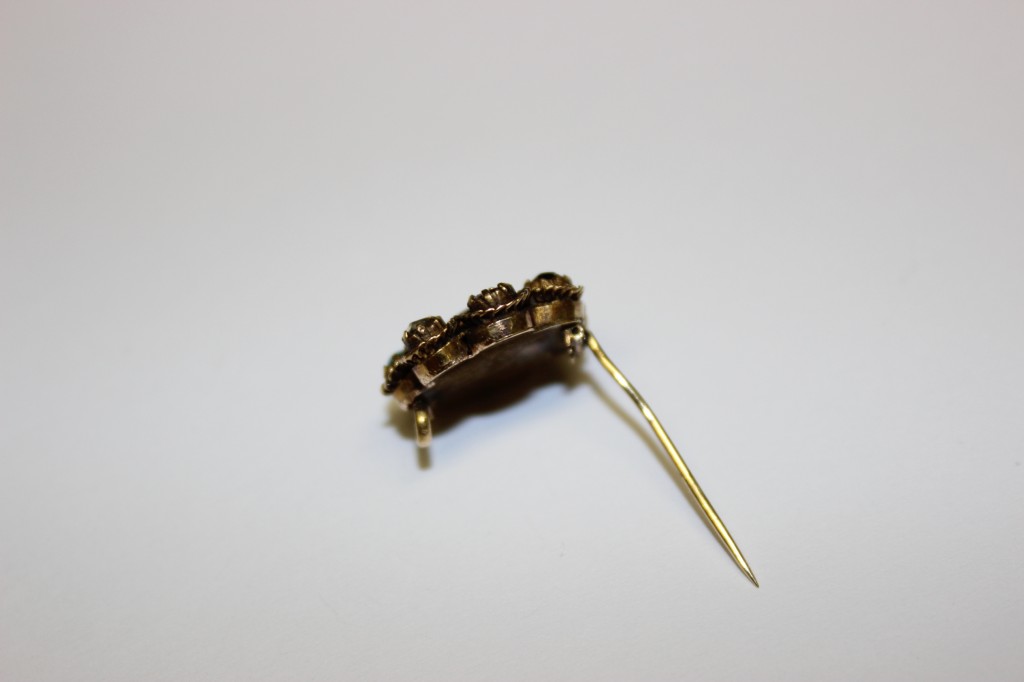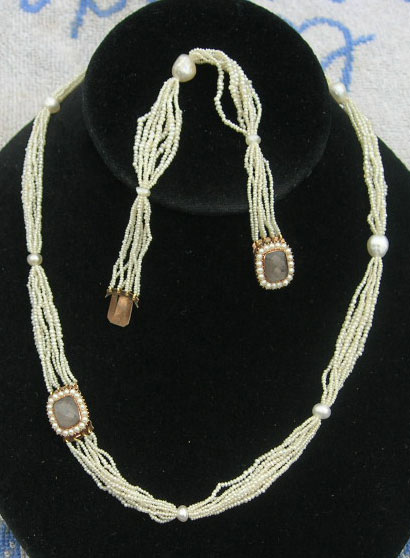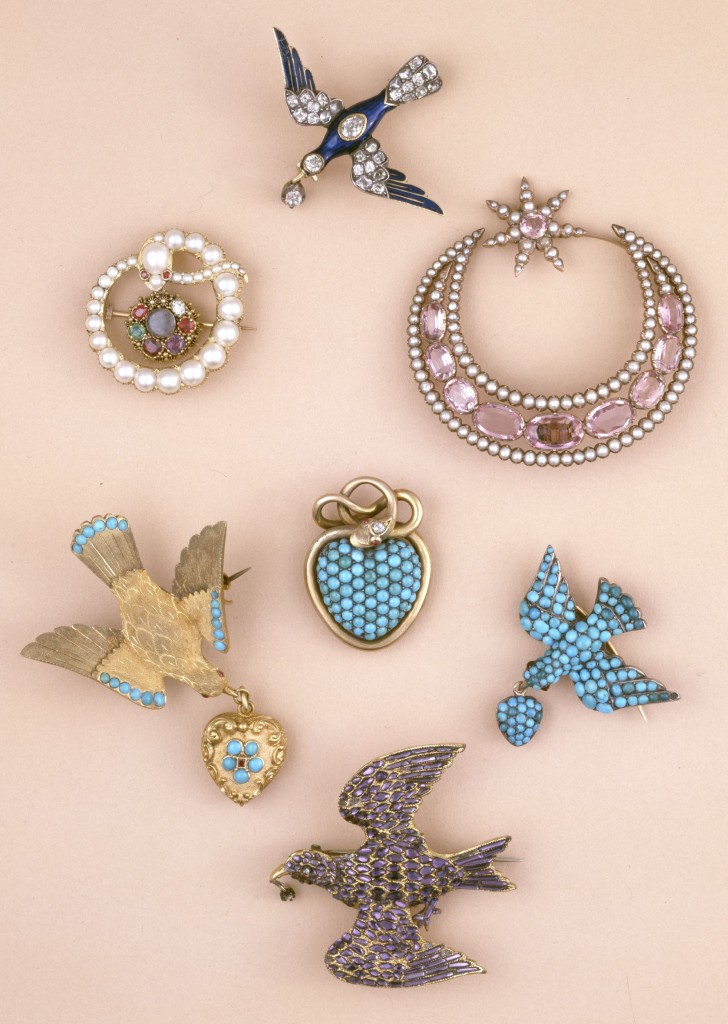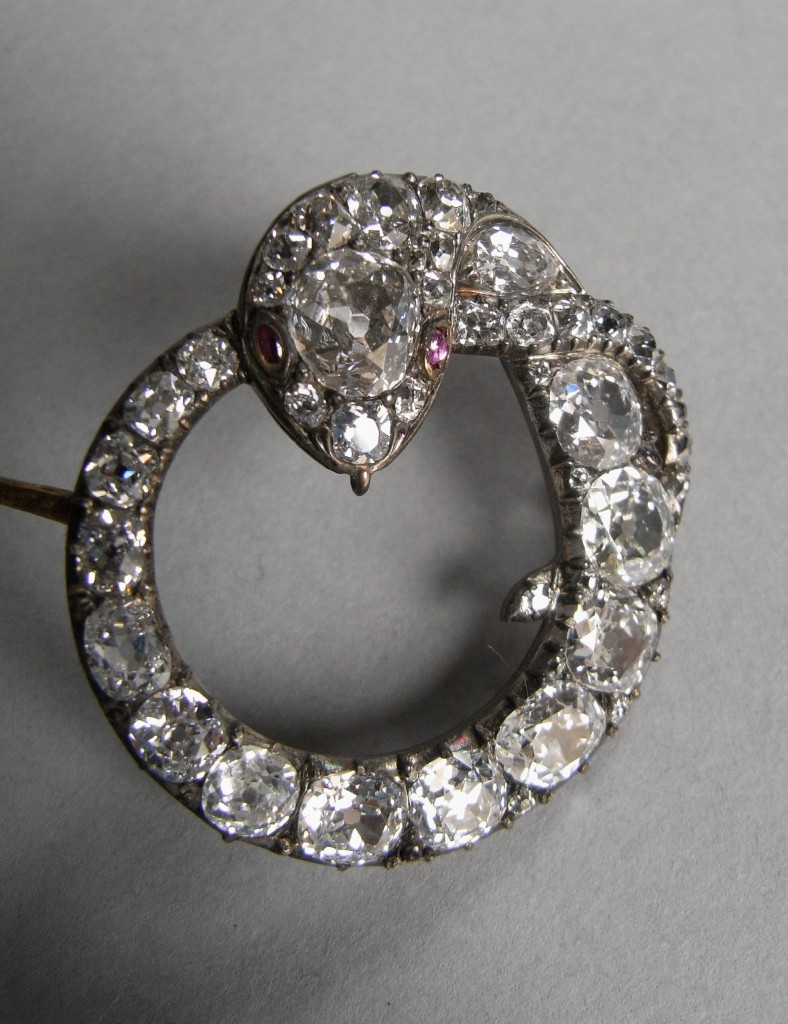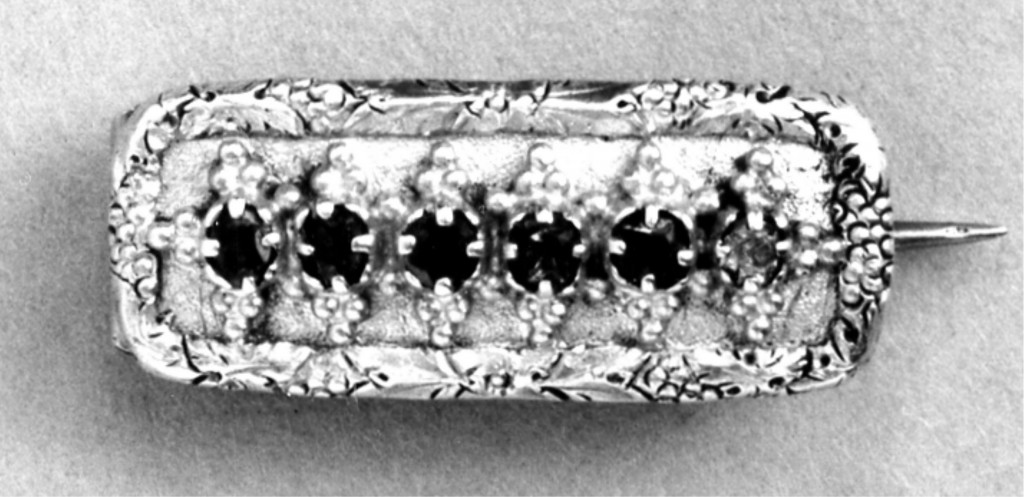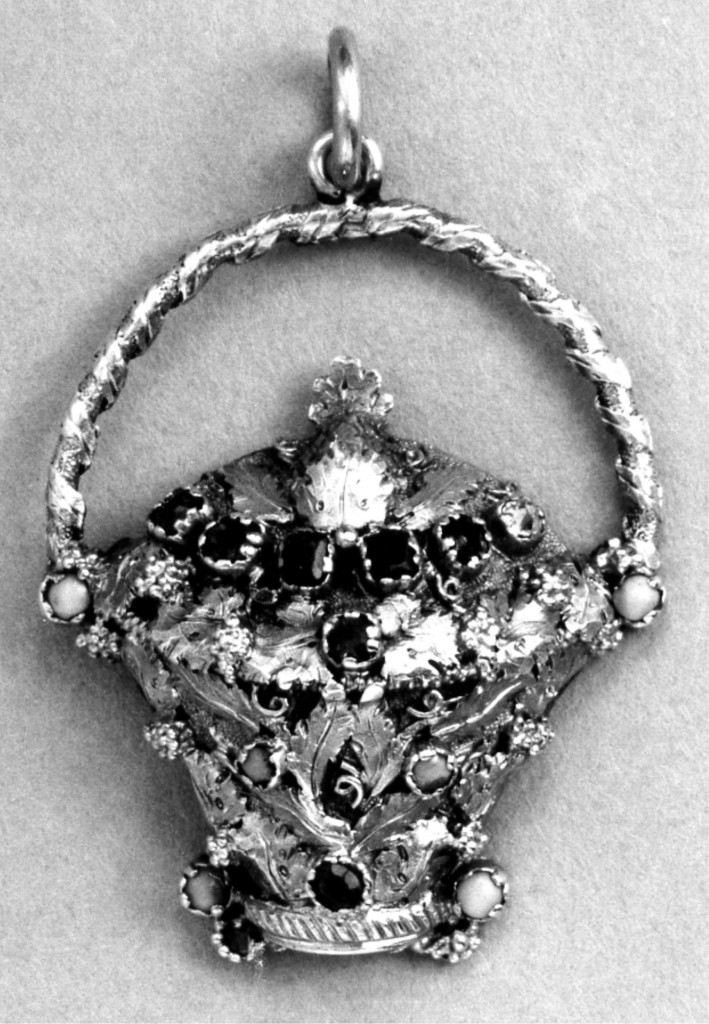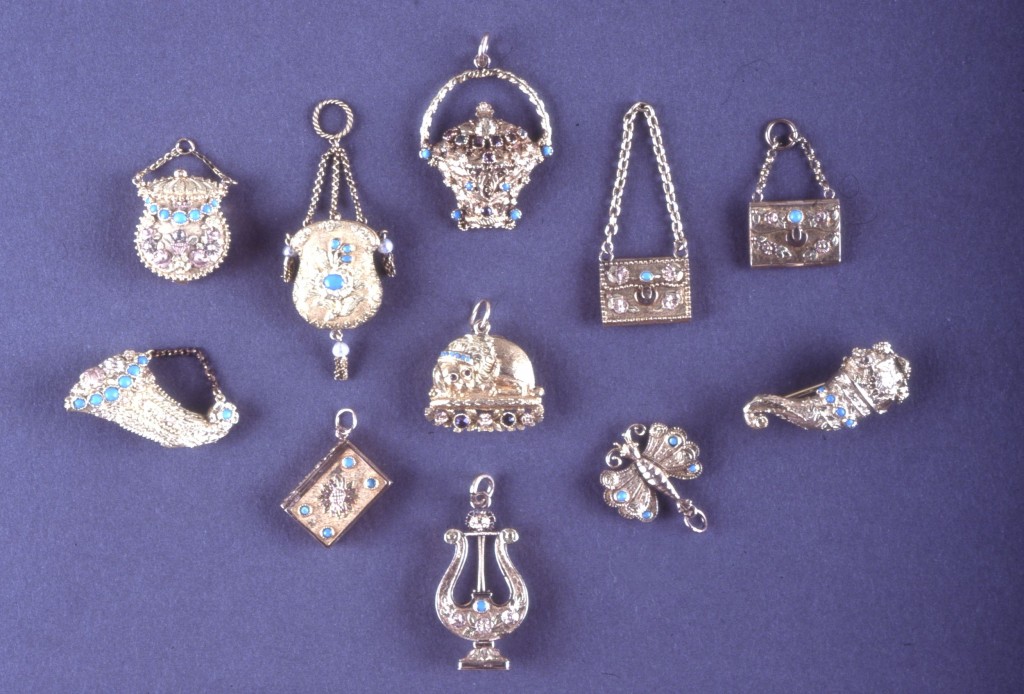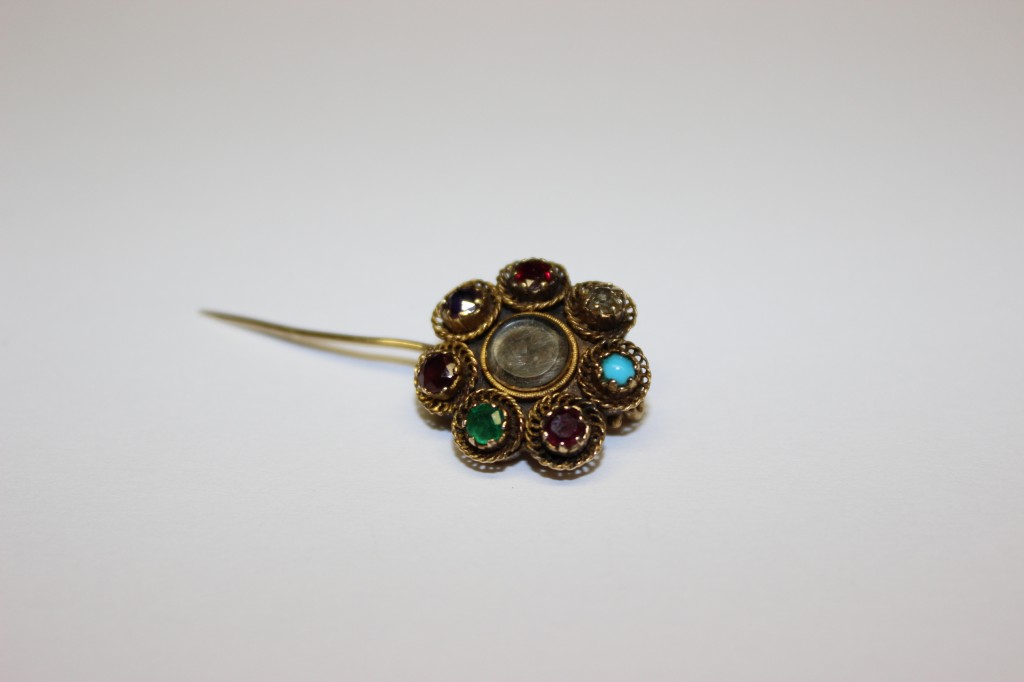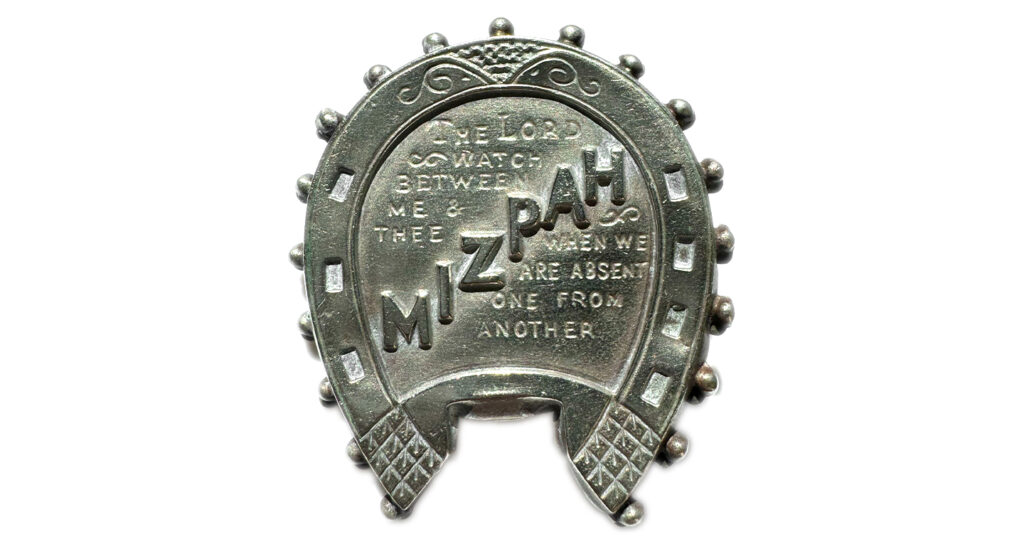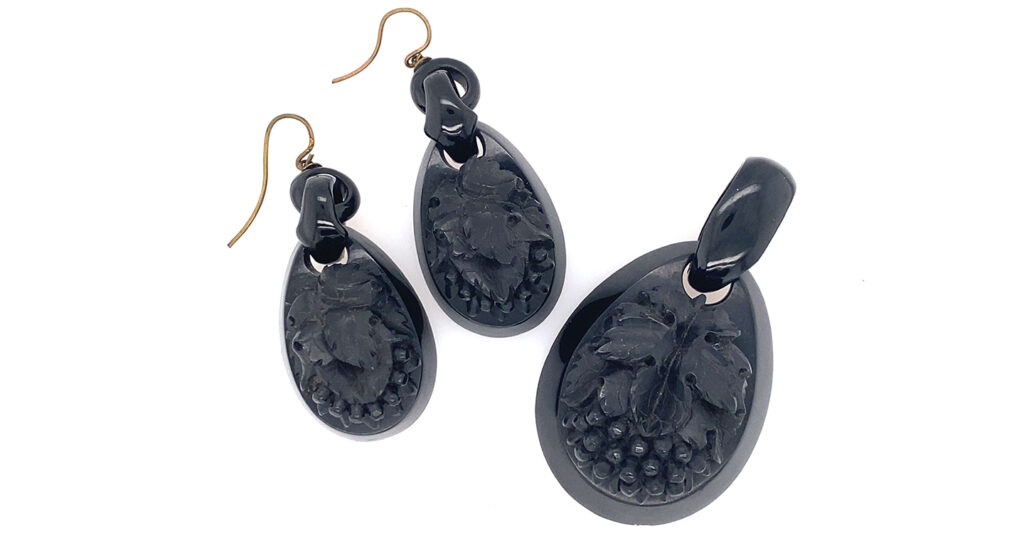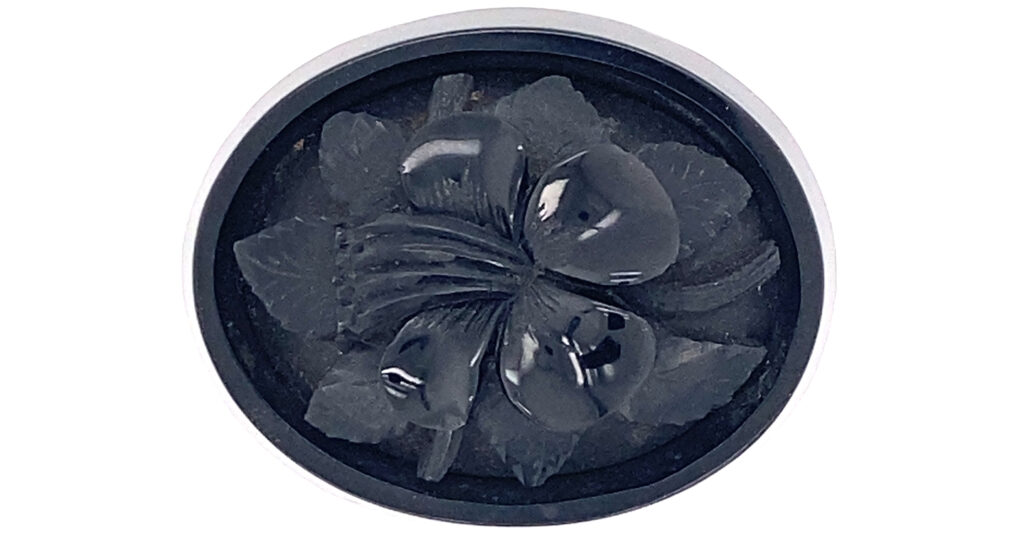A Mourning Tour: The Georgian “REGARD” Brooch
Jewellers and goldsmiths who had a close proximity to the crown benefitted from the attention and fame that their patronage would bring. These are the agents of change which can define the direction of fashion and art, resonating through a society and changing symbolism and identity. The late 18th century began a uniform of change throughout society, spanning continents and affecting the lives of those within Western culture. With great change comes challenge to previous thought and fashion and throughout the late 18th and early 19th centuries, there was great challenge to both, rapidly changing what was seen as acceptable in day to day life and wear.
Acrostic jewellery, such as the one in today’s article, had their suggested inception c.1809 through the French jewellery Mellerio, with the first letters of the gemstones becoming the word of the love token dedication. The effect of this was prodigious, with the style being replicated and accepted in mainstream society for the following twenty years and remaining a style that is still in production today.
There are many social, political and cultural values that made this happen. It was not as simple as an adapted design worn by royalty to generate this movement; a ring like this needed an historic context. What were the values of the day and why did they produce such a fine brooch?
In 1789, the French Revolution affected jewellery wearing and production to a great extent. The First French Empire under Napoleon retained and grew the popular Neoclassical styled jewels, maintaining their position as the primary leaders of fashion. Even with the hostilities between 1793-1815, the English closely followed Parisian styles.
By its very nature of wealth, jewellery was seen as a status symbol in France; an identifier for aristocratic status. During the Terror, the very possession of jewels or belt buckles may be enough to condemn one to the guillotine, while those who gave their jewels to the cause were seen as supporters and others simply hid theirs away for financial security if fleeing the country.
Jewels that were sold off following the Terror flooded the European market and dropped the prices of gems. In Paris, the only jewels to remain popular were souvenirs of the Terror itself. Simple iron relics inscribed with commemorations about the storming of the Bastille, or pieces containing stone or metal from the Bastille. Jewellery, by essence is a token. A reminder for memory to signify a time or a relationship in time that others can identify you by. When a culture suffers such a dramatic change, the utilisation of jewellery to promote a political message is not only important for the person’s connection to a community, but for their very safety itself.
In 1797, the Paris Company of Goldsmiths was reinstated, after being abolished in 1791, reintroducing many of the goldsmiths from the reign of Louis XVI. By 1798, hallmarking was established in France, making it compulsory to stamp jewels under three standards of purity; 750, 840 and 920 parts per 1000. They were also stamped with a maker’s mark (the maker’s or sponsor’s initial) and symbol in a lozenge-shaped stamp.
Filigree jewellery and fine detail to gold work had its inception here, as there was as shortage of money and goldsmiths became inspired by French peasant jewellery to produce finely detailed gold with lesser materials. Seed pearls, basic gems (such as agates) were also popular, as can be seen in the following pieces:
In the above, we can see how the fashion of fine gold and the access to seed pearls from the Orient made for highly detailed and inexpensive jewellery. Large enough to be seen and influenced by the Neoclassical style, this was a society adapting to the hardships that they were surrounded by.
This ring is the product of the use and popularity of the carnelian in jewellery. As these elements become popular, they resonate throughout society and here we see it with the intaglio inscription of ‘pietas’ in a swivel ring.
In 1804, the Napoleon’s Empire was announced and luxury trades were renewed with vigour. Bijoutiers, who worked in ordinary materials and joailliers, who worked in precious stones benefitted from this rise in luxury, with Napoleon requesting the jewels from the former kings of France to be set in the Neoclassical style, essentially connecting him to the Greco-Roman empires. His coronation crown was decorated with cameos and his passions for the antique world led him to establish a school of gem engraving in 1805. If ever there was a height for the Neoclassical period, it was this connection to it. How other societies would reflect this moment is seen in their contention or support of Napoleon. Here is a person who is appropriating the classical world in a time where it had been in mainstream thought and fashion for around forty years. International tension would only lead to the decline of this style, as cultures needed to obtain their own identities in jewellery fashion. A great push to the Gothic Revival style in England has its roots in this.
Simple designs and smaller jewels following in this early 19th century period. The geometric shapes, ovals, circles and rectangles became popular, with the Greek key pattern utilised often in jewels. It was about balance, with many patterns being taken directly from Greco-Roman architecture and detail. During this time, until his remarriage, Josephine was the bastion of style, maintaining the fashion which people would covet.
From this, what we see is that society had to adapt to the shock of the Terror and the new Empire, all the while other cultures are looking to France for its style and reestablishment. Greater and more literal influences of antique cultures led to the allegory of the sentimental depictions becoming literal interpretations of their architecture in jewels, making the individual the monument to classical art itself.
Within the 1790s, the ‘language of stones’ had its emerged, using the first letters of each gem to become the acrostic dedication of the jewel. The “Souvenir” jewels consistently reference “friendship” and this is a concept built from the nature of the relationship around piety and faith. As a concept itself, this is the very fundamental nature of a relationship, but in jewels, it can be seen written in posie rings from the 15th century onwards. ‘REGARD’, ‘DEAREST’ and ‘LOVE’ are the most English of the love token jewels from the 19th century to develop. This is due to the fascination and accessibility of precious stones, which allowed for the growing classes that had greater access to wealth the allowance to purchase jewels that would only have been accessible for the high aristocracy and Court.
REGARD: (R)uby, (E)merald, (G)arnet, (A)mythest, (R)uby, (D)iamond
LOVE: (L)apis-lazui, (O)pal, (V)ermeil (hessonite garnet) (hessonite garnet) and (E)merald
DEAREST: (D)iamond, (E)merald, (A)methyst, (R)uby, (E)merald, (S)apphire, (T)opaz
Other messages written in stones were not uncommon as the style became popular. Napoleon’s second wife Marie-Louise commissioned three bracelets made, dedicated with her and Napoleon’s dates of birth, dates of meeting and dates of marriage.
It cannot be understated how important the French influence upon sentimental jewels was in the turn of the 19th century. From the souvenir jewels stating such terms as “Souvenir d’amitié” and “Souvenir d’armour”, the statements of love that were worn on display created a new social proprietary that involved the use of sentimental jewels to offer admired people, within social circles, as signs of courtship and love.
Much of this sentiment stemmed from the French Revolution and its cultural challenge to established monarchy and religious value systems, particularly in the form of Liberté, égalité, fraternité (liberty, equality and fraternity). While the French Restoration of the first-quarter 19th century had repaired the monarchy itself, the challenge to established order had accomplished a lot to put new values in relationships and empower individuals. George IV encouraged society to look externally for artistic influence, since his ascendancy (and Regency, post Regency Act of 1811), George’s investment in the arts was required for the aristocracy to have these tokens of love as social requirements above simple affectations.
The Bourbons were restored in 1814, with jewels being more sedate in their designs due to the lack of wealth. Threaded seed pearl on horse hair created ornate bracelets and necklaces, with materials being smaller and more abundant to exaggerate their use. During the 1820s and 1830s, the use of cannetille (surface covered with wire) or grainti (small granules) embellished the colour of gemstones, as the gold was used in the base of the jewel. As seen with the portrait of Lady Peel by Sir Thomas Lawrence above, the wearing of several bracelets and enamelled rings on one finger elaborately exaggerated the colour of the jewellery. Classical style was starting to become overcome with elements of the Baroque and Rococo, which had only been popular previous to the Neoclassical period.
How this affected the mind of the early 19th century individual was a direct stylistic move away from what had bought about the unrest of the Neoclassical style. With competing styles being mixed for mainstream appeal, the classical style in its literal form would recede until the mid 19th century and the archaeological discoveries that would ignite it once more, such as Etruscan.
In the early 19th century, there was much to define the self through the identity of jewels. Neoclassical allegory had put the focus back upon the elements of the natural world which could contain their own symbolism. In the above image, the REGARD jewel is seen within the coiled serpent, denoting eternal love and piety. Given as a keepsake for a betrothed, all of the above jewels have a sentimental resonance, denoting futurity and an offering of new life and love.
Jewels of the time are often repurposed or added to, creating a marriage of styles that need to be considered for their elements. The above serpent may have had a REGARD sentiment in its centre, just as the dove, serpent and crescent selection of jewels, but as their sentiment still remains a popular one to this day, many jewels are given from generation to generation. There isn’t a clear statement of love in these pieces, but there is the simple nature of the decoration in their design and the underlying sentiment of their love. Unless one understands the acrostic sentiment of the piece, then it simply is just a beautiful jewel to be given to a loved one.
While the sentiment of the jewel is written in the message of REGARD, the style is important to note. REGARD jewels aren’t relegated to simple rings or the round shape of this article. Rectangular shapes, such as this piece from the British Museum, have all the elements of the Baroque coming back into style, while adapting to the smaller shapes of the classical style. Note the acanthus surrounding in the border design, alone with how the gemstones are set to the brooch.
Shape is the most obvious thing to identify a jewel of the early 19th century by. The navette shape, being large in the north-to-south, had to accommodate large Neoclassical depictions of love and death, while these jewels, through their simplicity and design, reflected the classical architectural shapes and became smaller. Miniatures remained to be popular, however, with many miniaturists creating pendants and keepsakes (which were held within compacts/cases) bespoke or tailored to a loved one through a Neoclassical ideal of what the face should be.
The early 19th century was about colour and classicism. These jewels had their own language and ‘magical properties’ that were tailored to the wearer through their birthstones or the very nature of being colourful. Paste, or coloured foil and glass, was more popular and affordable than the gems themselves. Many of the pieces that were created for REGARD jewellery in the Georgian period were often paste, yet still retain the message of love that the jewel was created for.
With the above images, the REGARD gemstones are set within a basket of flours, as well as rubies and turquoises. This is a testament to how popular the REGARD jewel was later in the 19th century, as this is a charm created with a compartment containing a photograph. Essentially, if the piece was not created simply for the containing of a photograph, it was repurposed by another generation to use the space for hair in a photograph.
And this is why the ring style is so popular today. As a gift for betrothal, it is an ideal way of offering love in a beautiful container. In the use of brooches and pins, it has lost favour, as the style is not one that fashion utilised. Indeed, if it was a fashionable item still used today, REGARD would certainly be seen in these items.
Gems
The gems of the ‘REGARD’ jewels were often paste as well as being the real material, however, that doesn’t distract from their meaning and sentiment. The jewels are still being produced today, as the sentiment of a love jewel like this doesn’t ever become an anachronism until the language changes; as long as we use/spell the word ‘regard’ the same way today, these jewels will be mass produced.
Look for original ‘REGARD’ jewels to have their gems also changed. Wearing a jewel that does not leave the popular lexicon will never leave fashion, hence many of these jewels have been worn down and repaired. Many novice jewellers change the gem order, voiding the sentiment, however, a keen eye can spot the original jewel.
Ruby
The ruby belongs to the gem species corundum (a relation to the sapphire). Burma produces many of the finest rubies in the world, a bright red, also known as ‘pigeon’s blood’. Thai rubies are darker and known as ‘Siam rubies’. Otherwise, rubies can be found across the Indian sub-continent and Sri Lanka. Their magic properties include those of being able to increase the wearer’s divinity, protect from illness and force.
Emerald
Belonging to the gem species beryl (which contains aquamarine, golden beryl and morganite), emeralds are found on their own, rather than the others of the family which are mined. Fine stones are step-cut (also emerald cut), small stones are brilliant cut and lesser stones cut en cabochon. While widely mined in history (Egypt, Columbia, Brazil), the most popular are the Russian Ural Mountains since 1830, Australia from 1890 and South Africa from 1920. Known to fracture, emeralds should be scrutinised, as flawless (or ‘clean’) emeralds may be synthetic. Their magical properties are through to be ‘unlucky’.
Garnet
There are primarily four types of garnet used in jewellery, varying wildly in colour (red to green). The ‘almandine garnets’ are the deep red/violet garnet, popular in late 18th and early 19th century jewels. In the 19th century, cutting the almandine en cabochon would make it become a carbuncle.
Demantoid garnets were found in Russia’s Ural Mountains post 1850, hence their lack of use before this date in earlier jewels. Their colour is bright green, closer to that of an emerald. Hessonite garnets are bright orange in colour, with their main supply stemming from Sri Lanka.
It is the ‘pyrotype garnet’ that is better known as the Bohemian garnet, due to their source being southern Europe, are deep red and mostly popular in Victorian jewels.
Amethyst
Associated with the Church, due to the the intrinsic connection through the colour purple (robes), they are used in Bishop’s rings and crosses. The purple colour also allows for a third-stage mourning colour to be used in costume after the 1817 statement on Court Mourning by Lord Chamberlain. The religious connection here cannot be overstated, especially post 1840 and with the instillment of family values by Queen Victoria, following on from the Gothic Revival movement. A perfect amethyst should be deep purple and reflect colours of red when turned in the light.
Diamond
Diamonds are the most precious of the gems to be found in mourning and sentimental jewels; often denoting what level of society would have commissioned the jewel. Throughout the 17th to 19th centuries, only the finest of the jewels created housed the diamond, along with the four other precious stones of the ruby, emerald and sapphire.
A symbol of fearlessness and love, the origins of diamond mining were in India, c.500BCE. From the early 18th century, diamonds were found in Brazil, leading to the rise in production in Europe through to the 19th century. The most dramatic finding of diamonds next came rom Australia in the mid 19th century and South Africa at the turn of the 20th century. Only by this time did diamonds begin to reach lower classes, as the cost had dropped considerably, but that doesn’t mean a diamond shouldn’t be graded for its condition. ‘Finest white’ is the highest grade for a diamond, with the next being ‘fancy’ (‘coloured’), with its associated colour.
Regarding
It should come as no mystery that this jewel was created for the very sentiment of connecting two people. Regardless of the elements that surround a jewel, the very nature of the piece is to remember a person. This person defined the very nature of the jewel and creates an element that is individual to its time. Upon the reverse, the following can be seen:
These are the initials of the loved ones and their memory when worn would have been enough to capture that love without any distance being lost between them. It is the small elements in fashion that really define its society. Society has its ways of creating identity in culture through the things that we wear, hence it is important that these things adhere to a sense of conformity, otherwise they don’t convey the message that another person can identify. Small elements of love are token and tableaus tailored to the person who identifies with them, but they lose their message over time. These messages need to resonate through a family if they are to be kept, such as a very important item to an individual, but that which cannot be understood by a modern viewer doesn’t share the message through which it was created for.
This is why REGARD jewels are so important. They go beyond the nature of the jewel and talk to the very sense of colour. When paste was used for REGARD jewels in contemporary times, they still had their message. That is why jewels which could talk to the values of love in gemstones are necessary for then and even now. These messages will resonate and evolve in their ways. Seeing as the nature of these came from the requirement of poverty and utilisation of sparse materials as well as a new leader who tried hard to identify with the classical world, a confluence of moments convened to produce jewellery of high value and importance for so many.




